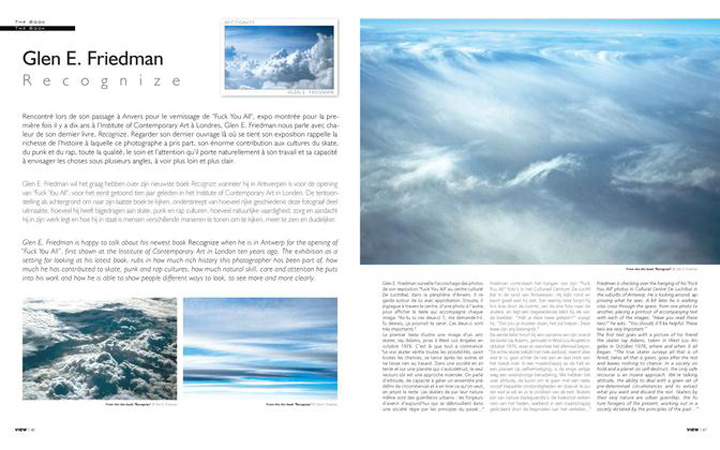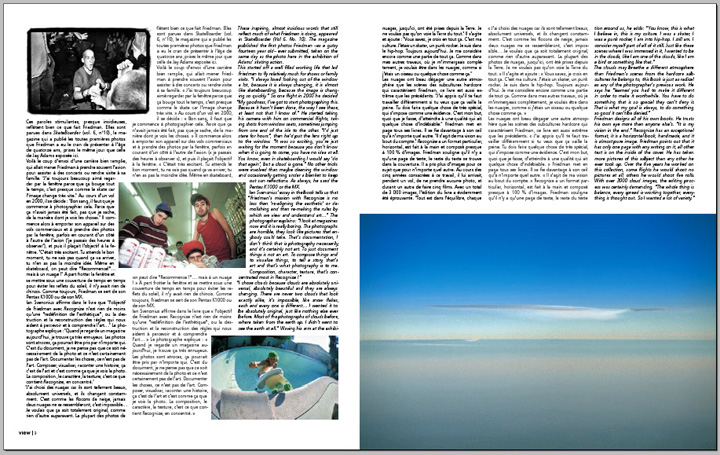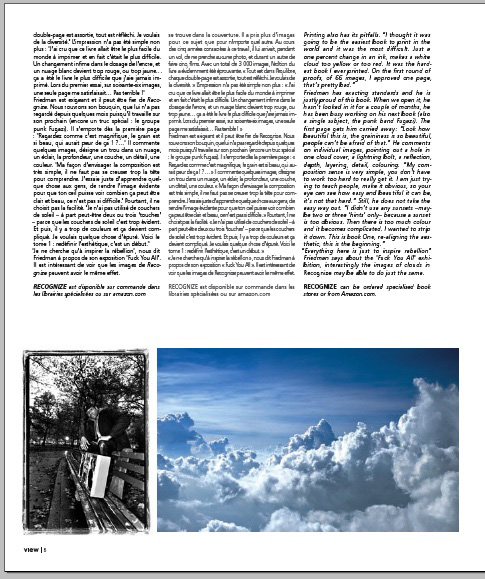VIEW
magazine
(from Belgium in French, Dutch and English) Summer 2007
the Book
Glen E. Friedman
R e c o g n i z e
Glen E. Friedman is happy to talk about his newest book RECOGNIZE when he is in Antwerp for the opening of FUCK YOU ALL, first shown at the Institute of Contemporary Art in London ten years ago. The exhibition as a setting for looking at his latest book, rubs in how much rich history this photographer has been part of, how much he has contributed to skate, punk and rap cultures, how much natural skill, care and attention he puts into his work and how he is able to show people different ways to look, to see more and more clearly.
Friedman is checking over the hanging of his FUCK YOU ALL photos in Cultural Centre De Luchtbal in the suburbs of Antwerp. He is looking around, approving what he sees. A bit later he is walking criss cross through the space, from one photo to another, placing a printout of accompanying text with each of the images. "Have you read these two?" he asks. "You should, it'll be helpful. These two are very important."

The first text goes with a picture of his friend the skater Jay Adams, taken in West Los Angeles in October 1976, where and when it all began. "The true skater surveys all that is offered, takes all that is given, goes after the rest and leaves nothing to chance. In a society on hold and a planet on self-destruct, the only safe recourse is an insane approach. We're talking attitude, the ability to deal with a given set of pre-determined circumstances and to extract what you want and discard the rest. Skaters by their very nature are urban guerrillas: the future foragers of the present, working out in a society dictated by the principles of the past..." These inspiring, almost insidious words that still reflect much of what Friedman is doing, appeared in SkateBoarder (Vol 6. No. 10 - 1976). The magazine published the first photos Friedman - as a gutsy fourteen year old- ever submitted, taken on the same day as the photo here in the exhibition of Adams' skating action.
This started off a well filled working life that led Friedman to fly relatively much for shows or family visits. "I always loved looking out of the window a lot, because it is always changing, it is almost like skateboarding, because the subject is moving so quickly." So one flight in 2000 he decided "My goodness, I've got to start photographing this. Because it hasn't been done, the way I see these, at least not that I know of." He started taking his camera with him on commercial flights, taking shots from window seats, sometimes jumping from one end of the isle to the other. "I'd just stare for hours", then he'd put the lens right up to the window. "It was so exciting, you're just waiting for the moment because you don't know when it is going to come, you have no idea at all. You know, even in skateboarding I would say 'do that again', but a cloud is gone." No other tricks were involved than maybe cleaning the window and occasionally getting under a blanket to keep out sun reflections. As always, he used the Pentax K1000 or the MX.

Ian Svenonius' essay in the book tells us that "Friedman's mission with RECOGNIZE is no less than 're-aligning the aesthetic' or demolishing and then re-making the rules by which we view and understand art..." The photographer explains: "I look at magazines now and it is really boring. The photographs are horrible, they look like pictures that anybody could take. That's documentation, I don't think that is photography necessarily, and it's certainly not art. To just document things is not an art. To compose things and to visualise things, to tell a story, that's art and that's what photography is to me. Composition, character, texture, that's concentrated most in RECOGNIZE"
"I chose clouds because clouds are absolutely universal, absolutely beautiful and they are always changing. There are never two clouds that are going to look alike, it's impossible...I wanted it to be absolutely original, just like nothing else ever before."
"Most of the photographs of clouds before, where taken from the earth up. I didn't want to see the earth at all." Waving his arm at the exhibition around us, he adds: "You know, this is what I believe in, this is my culture. I was a skater, I was a punk rocker, I was into hip hop. I still am. I consider myself part of all of it still." and "Just like these scenes where I was immersed in it, I wanted to be in the clouds, like I am one of the clouds, like I am a bird or something like that."
The clouds may breathe a different atmosphere than Friedman's scenes from the hardcore sub-cultures he belongs to, this book is just as radical as any of the photographer's previous work. He says he "learned you had to make it different in order to make it worthwhile. You have to do something that is so special they can't deny it. That is what my goal is always, to do something so good it can't be denied."
Friedman designs all of his own books. He trusts his own eye more than anyone else's. "It is my vision in the end." RECOGNIZE has an exceptional format, it is a horizontal book, handmade, and it is almost pure image. Friedman points out that it has only one page with any writing on it, all other text is on the inside of the covers.

He has taken more pictures of this subject than any other he ever took up. Over the five years he worked on this collection, some flights he would shoot no pictures at all, others he would shoot five rolls. With over 3000 cloud images, the editing process was certainly demanding. "The whole thing is balance, every spread is working together, everything is thought out. So I wanted a lot of variety." Printing also has its pitfalls. "I thought it was going to be the easiest book to print in the world and it was the most difficult. Just one percent change, makes a white cloud... It was the hardest book I ever printed. On the first round of proofs, of 66 images, I approved one page, that's pretty bad."
Friedman has exacting standards and he is justly proud of this book. When we open it, he hasn't looked in it for a couple of months, he has been busy working on his next book (also a single subject, the punk band Fugazi). The first page gets him carried away: "Look how beautiful this is, the graininess is so beautiful, people can't be afraid of that." He comments on individual images, pointing out a hole in one cloud cover, a lightning bolt, a reflection, depth, layering, detail, colouring. "My composition sense is very simple, you don't have to work too hard to really get it. I am just trying to teach people, make it obvious, so your eye can see how easy and beautiful it can be, it's not that hard." Still, he does not take the easy way out. "I didn�t use any sunsets -maybe two or three 'hints' only- because a sunset is too obvious. Then there is too much colour and it becomes complicated. I wanted to strip it down. This is book One, re-aligning the aesthetic, this is the beginning."
"Everything here is just to inspire rebellion" Friedman says about the FUCK YOU ALL exhibition, interestingly the images of clouds in RECOGNIZE may be able to do just the same.
RECOGNIZE can be ordered at specialised book stores or from Amazon.com.
View photography magazine is a Belgian magazine, independent in its choices and editorial structure.
The idea came a few years ago. And in 2005 the magazine was founded by Stephan De Broyer, the Chief Editor. Ever since View is a platform for contemporary photography but also an open door on cinema image creation, through which the reader discovers the different faces of the big screen and its protagonists.
The very purified style though rich in content, already greeted many times, unveils the essential side of hors format magazines. The print on high grammage mat paper, the varnish, the graphics of the minimalist cover offer the image and the text a great occasion to coexist and also reinforce the idea of qualitative portfolio. The quarterly frequency invites the readers to dive into the different portfolios presented by the columnists or the photographers themselves. It also allows the publishing of original editorial material.
View is definitely not a consumer media, the philosophy and the «object» look make you want to collect it or start your own collection. Why not!
Professionals or amateurs, journalists, professors or students, gallery owners, the general public from the museums of photography and contemporary art make up, i.e., the basis of the editorial target of the magazine. The three-language edition (French, Dutch, English) opens widely and spontaneously to several communities, allowing exchanges and encounters of known or new worlds. The diffusion is well facilitated by the polyglot concept, showing once again an open mind on the planet and its numerous inhabitants.